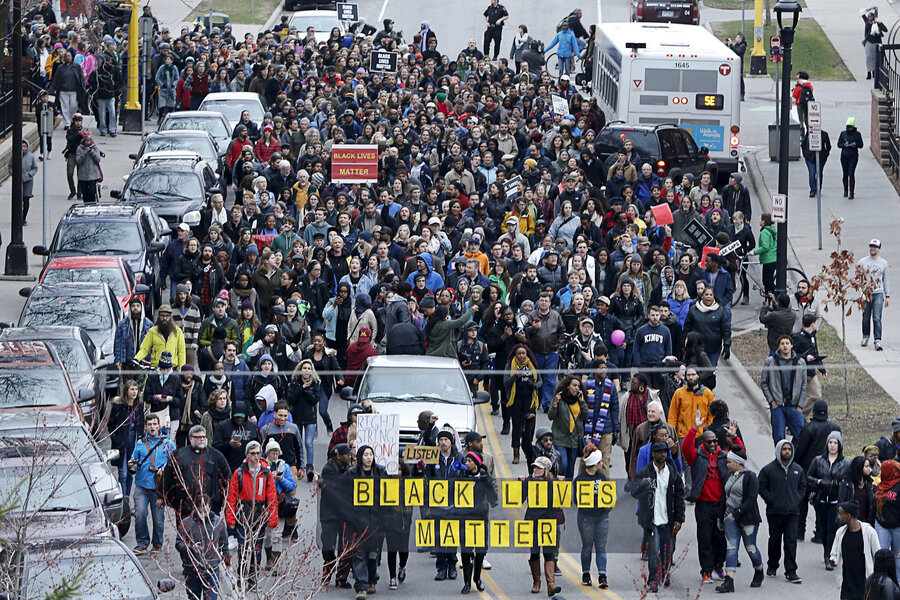For protesters, lack of charges in Minn. shooting is one more justice failure
Loading...
Wednesday's announcement that two Minneapolis police officers would not be charged in the shooting death of 24-year-old Jamar Clark hit many activists particularly hard, coming after they had pushed for months for the release of videos and other evidence in the November shooting.
The decision not to charge the two officers, who are white, in the death of Mr. Clark, who was black, is the latest episode in a series of ongoing tensions between minority communities and police departments around the country. Protesters around the country have become increasingly agitated by high-profile police killings of black men, and even more so by the rarity of charges against the officers involved.
On Wednesday, Hennepin County Attorney Mike Freeman said forensic evidence backed the statements of the two Minneapolis officers, who said Clark was not handcuffed during the confrontation and struggled for an officer’s gun when he was shot.
Mr. Freeman said Clark ignored warnings to take his hand off Officer Mark Ringgenberg’s gun, leading Officer Dustin Schwarze to shoot Clark as the officers said they feared for their lives. The confrontation, some of which was captured on video, lasted only 61 seconds.
The prosecutor said Officer Schwarze’s actions in shooting Clark were “reasonable” given Officer Ringgenberg’s warning to the officer that Clark had grabbed his gun.
“This case is not at all similar to others seen around the country,” Freeman said during the news conference. “These officers did not have the opportunity to negotiate or tactically withdraw.”
But while Freeman released a trove of investigative documents at a news conference and sought to contrast Clark’s death on a north Minneapolis street with those of Freddie Gray in Baltimore and Eric Garner in New York, activists who had pushed for more information in Clark’s death reacted with scorn.
“Your entire narrative today was to push the propaganda of the Minneapolis Police Department,” said Raeisha Williams, communications director for the Minneapolis NAACP and a candidate for Minneapolis City Council, the Minneapolis Star Tribune reports.
“You, Mr. Freeman, did not give a fair and accurate portrayal ... and let me tell you: If the city burns, it’s on your hands,” Ms. Williams said, later clarifying that she didn’t condone violence but said Freeman had made the wrong decision and would be responsible for the fallout.
"If we cannot find justice here, we will find it in the streets," Mica Grimm, an organizer with Black Lives Matter Minneapolis, told reporters after Freeman's announcement, the Associated Press reports.
After Clark’s death on November 15, protesters had maintained an encampment outside a police station for 18 days and led series of largely peaceful marches across the Twin Cities area. Many of the protesters gathered again at the Hennepin County Government Center where Freeman made his announcement.
The crowd swelled into the hundreds with many people carrying signs that read "Justice for Jamar" and "Black Lives Matter.”
The question of whether Clark had been handcuffed when he was shot was central to the case. Freeman said 20 civilian witnesses gave different versions of whether he was handcuffed, with two saying he wasn’t, six saying they weren’t sure and 12 saying he was. But they disagreed about whether both his hands were cuffed or whether his hands were cuffed in front of him or behind his back.
Freeman said none of 10 paramedics who saw Clark after the shooting saw him in handcuffs, and he hadn’t found any injuries on Clark’s wrists that could be consistent with handcuffs.
He told local station KSTP-TV that he had relied on “hardcore forensic evidence,” noting that Clark’s DNA was found on the butt of Clark’s gun and all over his utility belt, which appeared to support the officers’ statements that there was a struggle for the gun.
Minneapolis Mayor Betsy Hodges, Police Chief Janee Harteau, and Lt. Bob Kroll, the head of the police officers’ union, praised the thoroughness of the investigation, including Freeman’s release of thousands of pages of documents and videos that show parts of the confrontation, though not the shooting itself. The city has also made some changes to its training procedures for officers, the Star Tribune reports.
The department hasn’t yet made a decision on whether to discipline the two officers and is waiting for the outcome of a federal civil rights investigation and an internal review, Ms. Harteau said.
"We now expect all members of the public to peacefully accept the process and outcome that exonerated officers Mark Ringgenberg and Dustin Schwarze," Mr. Kroll said. "... I would ask the residents of Minneapolis to pause and reflect how we can move forward in a peaceful manner."
But activists said they were frustrated by the outcome of the case.
“We came here today expecting that there would be no charges filed in this case,” said Nekima Levy-Pounds, president of the Minneapolis NAACP. “We know that there has been a pattern of failure to hold officers who kill civilians accountable in the state of Minnesota, and today is no exception.”
This report contains material from the Associated Press.







